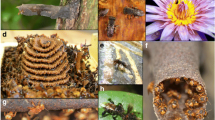Abstract
THE sting of the honey bee (Apis mellifera L.) carries volatile substances which incite bees to aggression. This was first demonstrated by Huber1, who elicited attacks by the guard bees when he placed freshly excised stings or the odour of stings near the hive entrance. Free2 found that cotton balls containing stings were more frequently stung than control balls.
Similar content being viewed by others
References
Huber, F., Nouvelles observations sur les abeilles, 2 (1814). Trans. Amer. Bee J., Hamilton, Ill., (1926).
Free, J. B., Animal Behaviour, 9, 193 (1961).
Karlson, P., and Butenandt, A., Ann. Rev. Entomol., 4, 39 (1959).
Author information
Authors and Affiliations
Rights and permissions
About this article
Cite this article
BOCH, R., SHEARER, D. & STONE, B. Identification of Iso-Amyl Acetate as an Active Component in the Sting Pheromone of the Honey Bee. Nature 195, 1018–1020 (1962). https://doi.org/10.1038/1951018b0
Issue Date:
DOI: https://doi.org/10.1038/1951018b0
- Springer Nature Limited
This article is cited by
-
Geosmin suppresses defensive behaviour and elicits unusual neural responses in honey bees
Scientific Reports (2023)
-
Identification and potential application of a putative allomone component in the defensive secretion of a destructive invasive species: the red-necked longhorn beetle, Aromia bungii
Journal of Pest Science (2023)
-
Antenna movements as a function of odorants’ biological value in honeybees (Apis mellifera L.)
Scientific Reports (2022)
-
Honeybee communication during collective defence is shaped by predation
BMC Biology (2021)
-
Olfactory coding in honeybees
Cell and Tissue Research (2021)





